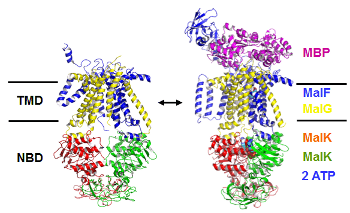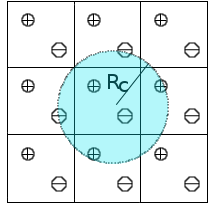Difference between revisions of "Research"
| Line 21: | Line 21: | ||
== QM/MM development == | == QM/MM development == | ||
[[File:Region_ips.png|frame|right|Schematic of the IPS method: interactions are computed explicitly up to a cutoff distance ''Rc''. Beyond that an average potential is used.]] | [[File:Region_ips.png|frame|right|Schematic of the IPS method: interactions are computed explicitly up to a cutoff distance ''Rc''. Beyond that an average potential is used.]] | ||
| − | We are | + | We are exploring new approach to include long-range electrostatic interactions in combined quantum mechanical and |
| − | + | molecular mechanical (QM/MM) calculations. Traditionally, long-range electrostatics in molecular | |
| − | + | simulations can be treated by lattice sum methods such as the Ewald method, where Coulomb interactions are collected over periodic systems in a manner that contributions from all particles including their periodic images are included without any truncation. The Isotropic Periodic Sum (IPS) method provides an efficient alternative to Ewald such that the pairwise interactions are only computed in a local region, where beyond this cutoff distance of the local region, the long range contribution is represented in a mean field fashion by assuming an isotropic distribution of image particles. The IPS method and has been developed and applied to classical systems including biomolecules and ionic systems <ref> ''Long-Range Lennard-Jones and Electrostatic Interactions in Interfaces: Application of the Isotropic Periodic Sum Method'', Jeffery B. Klauda,* Xiongwu Wu, Richard W. Pastor, and Bernard R. Brooks, ''J. Phys. Chem. B'', 2007, 111 (17), pp 4393–4400 </ref><ref>''Using the isotropic periodic sum method to calculate long-range interactions of heterogeneous systems'', Wu, Xiongwu,Brooks, Bernard R., ''J Chem Phys.'', 2008 October 21; 129(15): 154115</ref><ref>''Isotropic periodic sum: a method for the calculation of long-range interactions'', Wu X, Brooks BR., ''J Chem Phys.'',2005 Jan 22;122(4):44107.</ref><ref>''Isotropic periodic sum of electrostatic interactions for polar systems'', Wu X, Brooks BR.,''J Chem Phys. '', 2009 Jul 14;131(2):024107</ref>. We are currently developing computer code to extend the IPS method to treat systems that are described by combined QM/MM potentials. | |
==References== | ==References== | ||
<references /> | <references /> | ||
Revision as of 16:40, 8 August 2012
Our interests lie at the interface between theoretical/computational chemistry and biophysics. The current research in the lab is directed towards understanding how biomolecules perform their functions via dynamical motions that are encoded in their three dimensional structures. Ongoing projects include computer simulations of ABC-transporters and development of combined quantum mechanical/molecular mechanical (QM/MM) methods.
ABC-transporters
Many essential functions of living cells are performed by nanoscale motors consisting of protein complexes. The ability of these biomolecular motors to utilize chemical free energy to perform mechanical work makes them splendid molecular machines. Among various types of molecular motors, ATP-binding cassette (ABC) transporters represent a unique family of motor proteins that enable translocations of various substrates across cell membranes, by harnessing the free energy associated with ATP binding and hydrolysis. Dysfunctions of ABC-transporters have been linked to a number of diseases, including cystic fibrosis, the most common fatal hereditary disease in the US. The over expressions of certain ABC-transporters are also known to contribute to multidrug resistance of tumor cells after cancer patients receive chemotherapy. Making using multiscale computer simulations, our project aims at obtaining a deeper understanding of conformational dynamics, enzyme catalysis, as well as the chemomechanical coupling mechanisms under which the chemical free energy is converted into mechanical work in ABC-transporters. Currently, we are focusing on elucidation of ATP hydrolysis mechanisms in several ABC proteins.
QM/MM development
We are exploring new approach to include long-range electrostatic interactions in combined quantum mechanical and molecular mechanical (QM/MM) calculations. Traditionally, long-range electrostatics in molecular simulations can be treated by lattice sum methods such as the Ewald method, where Coulomb interactions are collected over periodic systems in a manner that contributions from all particles including their periodic images are included without any truncation. The Isotropic Periodic Sum (IPS) method provides an efficient alternative to Ewald such that the pairwise interactions are only computed in a local region, where beyond this cutoff distance of the local region, the long range contribution is represented in a mean field fashion by assuming an isotropic distribution of image particles. The IPS method and has been developed and applied to classical systems including biomolecules and ionic systems [1][2][3][4]. We are currently developing computer code to extend the IPS method to treat systems that are described by combined QM/MM potentials.
References
- ↑ Long-Range Lennard-Jones and Electrostatic Interactions in Interfaces: Application of the Isotropic Periodic Sum Method, Jeffery B. Klauda,* Xiongwu Wu, Richard W. Pastor, and Bernard R. Brooks, J. Phys. Chem. B, 2007, 111 (17), pp 4393–4400
- ↑ Using the isotropic periodic sum method to calculate long-range interactions of heterogeneous systems, Wu, Xiongwu,Brooks, Bernard R., J Chem Phys., 2008 October 21; 129(15): 154115
- ↑ Isotropic periodic sum: a method for the calculation of long-range interactions, Wu X, Brooks BR., J Chem Phys.,2005 Jan 22;122(4):44107.
- ↑ Isotropic periodic sum of electrostatic interactions for polar systems, Wu X, Brooks BR.,J Chem Phys. , 2009 Jul 14;131(2):024107

